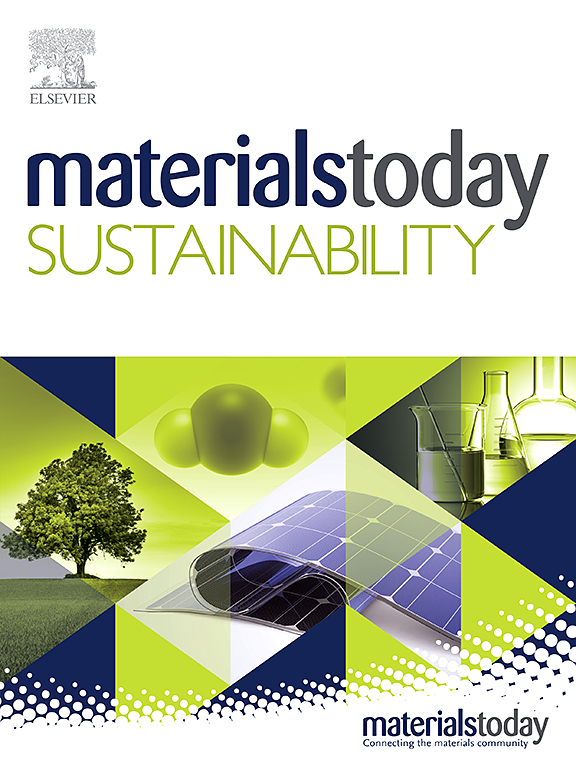废纸与大麻秸秆混合基质生产菌丝体基材料的研究
IF 7.1
3区 材料科学
Q1 GREEN & SUSTAINABLE SCIENCE & TECHNOLOGY
引用次数: 0
摘要
大麻鞭是流行的生产菌丝体为基础的材料(MBMs),这是新兴的生物材料包装行业。然而,大麻鞭已被重新用于替代用途,导致制造MBMs的基材的可用性有限和成本增加的潜在挑战。本研究旨在减少对大麻鞭作为基质生产MBMs的依赖。废纸更容易获得和成本效益高,在本研究中,将其与大麻草混合制成菌丝体基材料。制作时间和样品的物理和机械特性进行了评估,并与那些由纯麻绒基材。结果表明,混合基质制备的样品比100%大麻秸秆制备的样品生产时间更长。此外,不同的真菌种类有不同的消化杂交底物的能力,导致最终产物的形态不同。以孢子虫为基础的样品具有天鹅绒状和泡沫状的外观,以灵芝为基础的样品具有更紧密的结构,以短毛板为基础的样品具有松散的结构,表面菌丝皮肤较少。研究表明,在基材中加入废纸增加了最终产品的干密度。尽管如此,最终产品的干密度(0.097 g/cm3 - 0.145 g/cm3)仍然具有竞争力,因为它明显低于纸浆成型包装(0.2-1.0 g/cm3),这是一种常用的绿色包装材料。此外,加入废纸提高了产品的抗压性能。在35%应变下,以灵芝为基础的样品的抗压强度提高了13.9%,以红毛毡为基础的样品提高了25.7%,以短毛毡为基础的样品提高了30.8%。本文章由计算机程序翻译,如有差异,请以英文原文为准。
Investigation of hybrid substrates of waste paper and hemp hurds for mycelium-based materials production
Hemp hurds are popular for producing mycelium-based materials (MBMs), which are emerging biomaterials for the packaging industry. However, hemp hurds have been repurposed for alternative uses, resulting in potential challenges of limited availability and increased costs of substrates for manufacturing MBMs. This study aimed to reduce the reliance on hemp hurds as a substrate in the production of MBMs.Waste paper, which is more readily available and cost-effective, was blended with hemp hurds to create mycelium-based materials in this research. The fabrication duration and physical and mechanical characteristics of samples were assessed and compared to those made of pure hemp hurds substrates. The results showed that samples made of hybrid substrates exhibited longer production duration than those from 100 % hemp hurds. In addition, different fungal species have varying abilities to digest hybrid substrates, resulting in different morphology of the final product. Fomes fomentarius-based samples had a velvety and foam-like appearance, Ganoderma lucidum-based samples exhibited a more compact structure, and Trametes pubescens-based samples showed a loose structure with less mycelium skin on the surface. The study demonstrated that adding waste paper to the substrates increased the dry density of final products. Non-etheless, the dry density of the final products (0.097 g/cm3 – 0.145 g/cm3) remained competitive because it was significantly lower than that of pulp moulding packaging (0.2–1.0 g/cm3), a commonly used green packaging material nowadays. In addition, incorporating waste paper increased products’ compressive properties. Compressive strength at 35 % strain was increased by 13.9 % for Ganoderma lucidum-based samples, 25.7 % for Fomes fomentarius-based samples, and 30.8 % for Trametes pubescens-based samples.
求助全文
通过发布文献求助,成功后即可免费获取论文全文。
去求助
来源期刊

Materials Today Sustainability
Multiple-
CiteScore
5.80
自引率
6.40%
发文量
174
审稿时长
32 days
期刊介绍:
Materials Today Sustainability is a multi-disciplinary journal covering all aspects of sustainability through materials science.
With a rapidly increasing population with growing demands, materials science has emerged as a critical discipline toward protecting of the environment and ensuring the long term survival of future generations.
 求助内容:
求助内容: 应助结果提醒方式:
应助结果提醒方式:


